The firing pin on this rifles will not travel far enough to set off a properly seated primer (any primer I know of) unless the bolt is locked up. The L shaped leg of the firing pin wont allow it.
Not at all. The firing pin does not encounter the receiver bridge until cam down. Till then, the firing pin is totally free floating. Out of battery slamfires occur prior to cam down, that ought to be obvious. Of all the mechanisms on the market, and I mean all, Garand mechanisms have the most reported incidents of out of battery slamfires.
The receiver bridge was and always was, a firing pin retraction bridge. I am of the opinion that calling it a "safety" bridge is a creation from the early 60's. When I examine John Garands' patent, the functions of the firing pin tang and the firing pin retraction bridge are explicitly spelled out and neither as a firing pin block. Its primary function is to retract the firing pin at unlock. There is a slot allowing the firing pin to go forward when the bolt is in battery, but the function of the whole as a firing pin block is not claimed. The extractor is claimed as a means of holding the firing pin.
Patent 1 892 141 Semi Automatic Rifle. J. C. Garand Dec 27 1932
The firing pin is formed at its rear end with a laterally extending had 72 adapted to contact a projection 73 formed in the receiver when the bolt is in unlocked position so that the firing point is retracted into the bolt, but the head is cut away at 74 to pass such projection when the bolt is locked to permit the pin to be moved to its extreme forward or firing position.
"I claim":
5. The combination with a gun provided with a receiver, of a bolt receiprocable in the receiver, a firing pin reciprocal in the bolt, a laterally extending head for the pin and means in the receiver to engage the head on rocking of the bolt to unlocked position to retract the pin
6. The combination with a gun provided with a receiver, of a bolt reciprocable in the receiver, a firing pin in the bolt, an extractor carried by the bolt, and means on the extractor to prevent rotation of the pin with respect to the bolt.
7. The combination with a gun provided with a receiver, of a bolt reciprocable in the receiver, a firing pin in the bolt, an extractor carried by the bolt, and means on the extractor cooperating with the pin to limit movement thereof.
8 The combination with a gun provided with a receiver, of a bolt reciprocable in the receiver, a firing pin in the bolt, an extractor carried by the bolt, and means on the extractor to limit reciprocatory movement of the pin with respect to the bolt and prevent rotary movement thereof with respect thereto.
The Garand mechanism is an early semi automatic weapon design. It is my opinion that later mechanisms incorporated more thought into preventing incidental firing pin contact with the primer prior to lug engagement. As an example, AR mechanisms fully retract the firing pin until cam down. This is a very positive means of preventing firing pin initiated out of battery slamfires. If the firing pin is fully behind the bolt face till lug engagement, the primer is 100% protected from incidental contact with the firing pin. Credible out of battery slamfire incidents in AR’s are very rare. Armalite provides extensive large print warnings not to remove the firing pin spring in their AR10 actions.
Technical Note 10: Prevention of Slamfires explicitly states that the firing pin spring reduces the inertial impact energy to a very safe level and
almost always cures slamfires.
http://www.armalite.com/images/Tech Notes\2015\Tech Note 10, Prevention of Slamfires 981226.pdf I don’t believe their statement that Government and commercial large rifle primers are not “Hardened” in the same way as the Government #41 primer. (Based on talks with CCI, commercial large primers are more sensitive than the #34 primer) Armalite is correct that free floating firing pins will lightly impact a cartridge primer and, very rarely, cause the primer to ignite. Their technical bulletin advises to always feed from the magazine, because the friction of stripping a round from the magazine slows the bolt, and to never, ever, remove the firing pin spring. In
Technical Note 59: AR-10(T) Addendum to USMC M16A2 Technical Manual there is a picture of the Armalite spring on a firing pin and the large print notice:
”WARNING: THE FIRING PIN SPRING IS AN IMPORTANT SAFETY DEVICE AND MUST NOT LOOSE, REMOVED, OR LOST” From
Armalite Operator’s Manual http://usarmorment.com/pdf/AR10M15OperatorsManual.pdf
The AR-10 firing pin spring reduces the firing pin mark on the primer of a chambered cartridge that is chararacteristic of M-16 type rifles, and the “slamfire” possible with overly sensitive primers”. “THE FIRING PIN SPRING IS AN IMPORTANT SAFETY DEVICE AND MUST NOT BE LOOSE, REVERSED, REVOVED, OR LOST.”
Simonov’s SKS and the Fabrique Nationale FAL were extremely hard to find in the US prior to the Reagan administration, but since then they were imported in mass quantities. There is a domestic manufacturer of the FAL so supplies won't be as tight as they were prior to the 1980's. Both mechanisms are examples of designs that use a titling breech face to reduce the possibility of an out of battery slamfire. In both of these designs the bolt face is out of perpendicular from the case head until the bolt is in battery. This keeps the firing pin out of parallel with primer until the bolt faces rises as the bolt goes into battery. Both of these rifles have free floating firing pins, the FAL has a firing pin spring to reduce the chance of a slamfire and so do some models of Russian SKS’s. I never saw a Chinese SKS that had a firing pin spring and there are plenty of in-battery slamfires reports, most particularly the SKS, due to firing pin inertia with either of these models. Murray’s sells a SKS firing pin spring to reduce firing pin impact on bolt closure.
http://www.murraysguns.com/sksown.htm.
There are a few firearm designs which don’t manually retract the firing pin and the SKS and FAL are among them. For these designs it is safety critical to keep the firing pin channel clean to prevent the firing pin from being wedged in a forward position. Here, Murray performs an insanely risky test with an SKS. He has wedged the firing pin forward and the gun fires until the rifle is empty.
https://www.youtube.com/watch?v=xj3QtnUWCwQ The primary reason the rifle does not have an out of battery slamfire is due to the titling breech face design of the mechanism, but given a long enough firing pin, I don’t see any reason why an out of battery slamfire could not happen.
Here is a video of an SKS which the owner claims is well maintained and it slamfires in battery.
https://www.youtube.com/watch?v=mPn97vz0Vyw
D.J Saive, the designer of the FAL, in the earliest version, the FN49, inside the patent there is an explicit claim for a firing pin blocking feature.
Tilt Locking Breechblock for Automatic Firearms D. J. Saive July 18, 1950, 2,515,315
The spring 32 also forms a safety device (Figure 14) for preventing firing when the breech block is unlocked. As shown in 'Figure' 14, the firing
pin 31 has a groove 31a in it and the spring 32 has a lug 32a on it which acts as a safety and, by engaging in the groove 31a, holds the firing pin against forward movement when the breech block is unlocked . When the breech block is not locked (Figure 8) the rear end of the slide projects beyond the rear end of the firing pin thus preventing the striker from striking said firing pin.
You can see a picture of the firing pin safety stop here:
http://milpas.cc/rifles/ZFiles/Semi-automatic Rifles/FN 59/bolt disassembly.htm
Unfortunately, as anyone who has searched, the firing pin safety stop has not been positive in function as there are lots of accounts of out of battery slamfires in the FN 49. One cause is a weak firing pin that breaks and sticks out through the bolt face, but there are a number of accounts where the firing pin was found to be intact and not stuck within the barrel channel.
Something must have changed with the FAL, while in battery slamfire accounts are easily found, out of battery slamfire accounts are rare.
As can be seen with this FAL bolt, when it is unlocked, the firing pin center of axis is off set from the primer center. Any incidental firing pin contact is less likely to ignite the primer. Data shows that the further the firing impact is from the center of the primer, the greater the misfire rate. Primers need to be hit in the middle for positive ignition.
Another feature is that the breech face is out of perpendicular with the cartridge base. Only at lockup does the bolt face and firing pin square up. There could be out of tolerance conditions that could create incidental firing pin contact with the center of the primer, but in this mechanism, such events are rare.
FAL Bolt out of battery
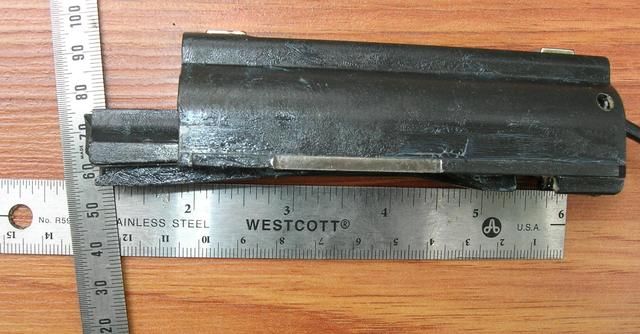
FAL Bolt in battery
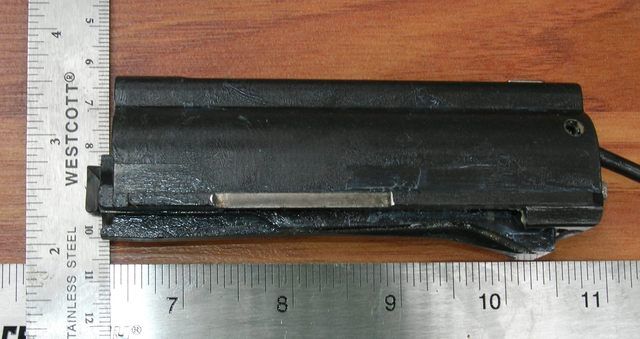
I am impressed with the HK roller bolt actions. The primary concern of the German designers was to create a rifle that could be quickly and inexpensively mass produced, a goal they achieved, and they also produced an easy to maintain and safe rifle. I have never heard of any in battery or out of battery slamfire events in the roller bolts and I am of the opinion that a firing pin induced out of battery slamfire is totally impossible in this design without part breakage. The firing pin absolutely cannot move forward of the breech face until the rollers are in battery:
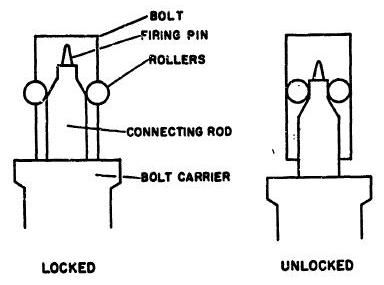
These are pictures of the bolt mechanism of my PTR 91, you can see the firing pin spring, “connecting rod” and bolt.
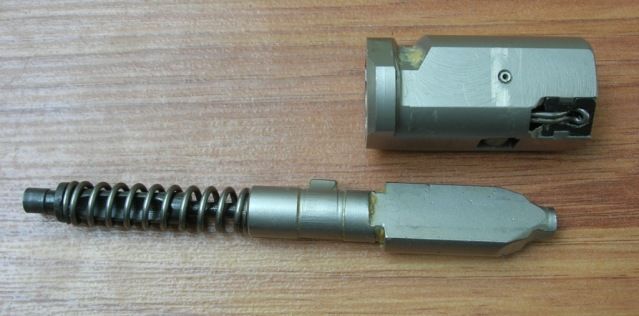
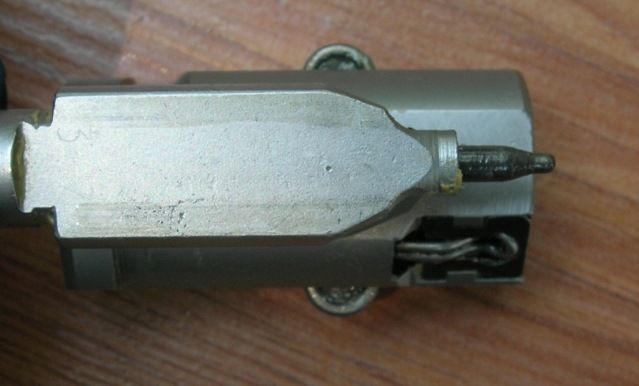
The firing pin mainspring is very strong, much stronger than I have found on any of the actions I own. To call this firing pin “free floating” is almost an oxymoron as spring tension must keep the firing pin in place regardless of firing pin inertia.
Of the military actions on the market, the Garand mechanism has the most reports of slamfires. One reason has to be the hundreds of thousands of Garands that have been imported and are now in civilian hands. Another reason is that the Garand action has a long free floating firing pin. This mechanism does not positively hold the firing pin throughout the feed cycle and the firing pin is always in line with the centerline of the cartridge case. Due to these characteristics the Garand mechanism will not only slamfire in battery, but out of battery. I am of the opinion that the US Army controlled slamfire rate in the Garand (and M14) by specifying a relatively insensitive primer. I am of the opinion this was how most militaries controlled slamfires in their issue rifles: primer insensitivity. On page 58 of the April 2011 Guns Magazine Mike Venturino reports having a in battery slamfire in a K43 and SVT40 rifle with standard primers. These slamfires ended when he used #34 primers.
High primers can cause slam fires. Loose primer pockets and backed out primers may cause this.
CCI says high primers are the most common cause of misfires. There is a lot of pistol ammo cranked out on progressives with high primers, and yet, I don't read of slamfires problems in auto pistols. If high primers are the primary slamfire mechanism, which your post implies, how come semi auto rifles are the one having slamfires, and not semi auto pistols?
It is my opinion that high primers are the least likely cause of slamfires.
If you're still concerned, call the CMP Custom Shop and ask the armors. This topic comes up in the Advanced Maint. Courses (or at least it did mine), and the answer is aways the same, as I mentioned above.
Fan boys may believe whatever they want to believe. After my experiences, I consider these types delusional. I rely on observations in the real world, they base their religion on authority and ignore all evidence contrary. Did these experts ever discuss why every semi automatic mechanism in every semi automatic rifle has had a posted slamfire? I have pages of slamfire incidents that I have copied from web posts, many with factory ammunition. The world has gotten larger since the inbred world of the DCM and the NRA and their old worn out religion that slamfires are only caused by high primers and worn out receiver bridges. Prior to the mid 1990's, hardly anyone had anything other than a Garand or M1a, then the Colt AR15 monopoly was broken, good President Reagan allowed the import of huge quantities of military surplus rifles. Shooters had access to SKS's, FAL's, Russian rifles, Swedish, French, and every one of these has a slamfire incident, many with factory ammunition. Try to find an out of battery slamfire incident with one of these.
Did these CMP experts ever discuss this? These rifles were gaged for compliance, were being shot with Government ammunition in Government test, and one, slamfired out of battery. How could that have happened? I have a paper copy of this report. The Army was testing production models of H&R’s and SA’s for dimensional part compliance, (part interchangeability), such things as the thickness of the chrome coatings were measures, rifles were reassembled after gaging and underwent endurance testing.
USATECOM Project No 8F-3002-04, Comparison Test of rifles, 7.62 MM, M14 Manufactured by Springfield Armory and Harrington and Richardson Arms Company. Author G. E. Hendricks, July 1963.
At round 5271 a Springfield Armory M14 went off out of battery, with military ammunition. The report states:
“One rifle fired when the bolt was in the unlocked position causing breakage for the firing pin, extractor, bolt roller, ejector, and stock. The magazine split, causing the magazine floor-plate spring and 12 rounds of ammunition to be ejected against the bench rest from which the rifle was being fired. The case ruptured and several pieces of brass were found in the area. A broken part of piece of brass perforated a cardboard box with was position between the gunner and the proof director. The cardboard box was used as a brass catcher. Not all the broken pieces were found. Although no one was physically injured this is a seriously unsafe condition.”
So, six rifles were tested, five completed the test firing 6000 rounds each, one slamfired out of battery at round 5271, for a total round count of 35, 271. Therefore the probability of an out of battery slamfire with mil spec primers is 1:35,000.





